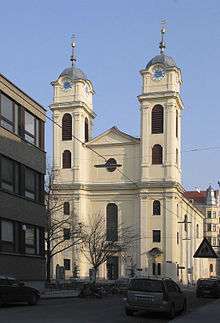Mass No. 4 (Schubert)
Mass No. 4 in C major, D 452, is a mass composed by Franz Schubert in 1816. It was originally scored for soprano, alto, tenor and bass soloists, SATB choir, violin I and II, and basso continuo (cello, double bass and organ). It is classified as a missa solemnis.[1]
| Mass No. 4 | |
|---|---|
| by Franz Schubert | |
 Lichtental Church | |
| Key | C major |
| Catalogue | D 452 |
| Year | 1816 |
| Form | Missa solemnis |
| Movements | 6 |
| Vocal | SATB choir and soloists |
| Instrumental |
|

Background
The setting was composed in June–July 1816, and possibly received its first performance in late summer or early fall of the same year at the Lichtental Church.[2] As in his previous masses, the soprano solos were written with Therese Grob's voice in mind.[3]
The mass shows the influence of Mozart in Schubert's work, particularly in the original reduced orchestration (the Salzburger Kirchentrio, Salzburg church trio)[4] and the perceived "lightness of touch".[5] Schubert's contemporary diary entries confirm his interest in Mozart's missae breves, along with the music of Michael Haydn, another Salzburg composer.[3]
Schubert made considerable revisions to the mass for subsequent performances. He added parts for 2 oboes or clarinets, 2 trumpets and timpani, all ad libitum, for an 1825 performance in St. Ulrich, Vienna.[2] He revisited the mass in 1828, seven weeks before his death, with a purely choral setting of the Benedictus (D. 961) to replace the earlier soprano solo.[6][7] It is likely that this was in anticipation of a performance where a soloist of Grob's calibre was unavailable.
Schubert sold the score of Mass No. 4 and some shorter church works to Anton Diabelli for publishing in 1825.[8] It was the only mass published during the composer's lifetime.[9] Schubert dedicated the publication to Michael Holzer, the organist and choirmaster at the Lichtental church, and his teacher in organ, singing, figured bass and counterpoint.[10]
Structure
The mass consists of six movements. Performances require approximately 23 minutes. Commentary is for D 452, unless otherwise indicated.
- Kyrie, Andante con moto, C major, common time
- Gloria, Allegro vivace, C major, common time
- Credo, Allegro, C major, 3/4
- Et incarnatus est, Adagio molto, D minor, cut common time
- While Schubert habitually omitted certain passages of the Creed, in this mass he makes the unusual exclusion of the words "ex Maria Virgine" (of the Virgin Mary).[3]
- Et resurrexit, Allegro, C major, 3/4
- Et incarnatus est, Adagio molto, D minor, cut common time
- Sanctus, Adagio, C major, common time
- Osanna in excelsis, Allegro vivace, C major, common time
- Benedictus, Andante, F major, 2/4; soprano solo
- Osanna in excelsis, Allegro vivace, C major, common time
- Benedictus, (D 961) Moderato, A minor, cut common time; choir
- Osanna in excelsis, Allegro vivace, C major, common time
- Agnus Dei, Adagio, C major, common time
- Dona nobis pacem, Allegro vivace, C major, 3/4
Notes
- Shrock 2009, p. 383.
- Howie 2008, p. 70.
- Black 2003, p. 41.
- Gibbs 1997, p. 210.
- Newbould 1999, p. 137.
- Black 2003, p. 183.
- Newbould 1999, p. 138.
- Hall 2003, p. 81.
- Newbould 1999, p. 452.
- Newbould 1999, p. 20.
References
- Black, Leo (2003). Franz Schubert: Music and Belief. ISBN 9781843831358.CS1 maint: ref=harv (link)
- Gibbs, Christopher H. (1997). The Cambridge Companion to Schubert. Cambridge Companions to Music. ISBN 9780521484244.CS1 maint: ref=harv (link)
- Hall, Michael (2003). Schubert's Song Sets. ISBN 9780754607984.CS1 maint: ref=harv (link)
- Howie, Crawford (2008). "Small is beautiful: Schubert's smaller sacred works". In Reul, Barbara M.; Bodley, Lorraine Byrne (eds.). The Unknown Schubert. ISBN 9780754661924.CS1 maint: ref=harv (link)
- Newbould, Brian (1999). Schubert: The Music and the Man. ISBN 9780520219571.CS1 maint: ref=harv (link)
- Shrock, Dennis (2009). Choral Repertoire. ISBN 9780199716623.CS1 maint: ref=harv (link)
External links
- Mass No.4, D.452: Scores at the International Music Score Library Project (IMSLP) (includes soprano and choir settings of Benedictus; 1825 orchestration with wind, brass and timpani)
- Free scores of Mass No. 4 in C major, D452 in the Choral Public Domain Library (ChoralWiki) (choir setting of Benedictus only)